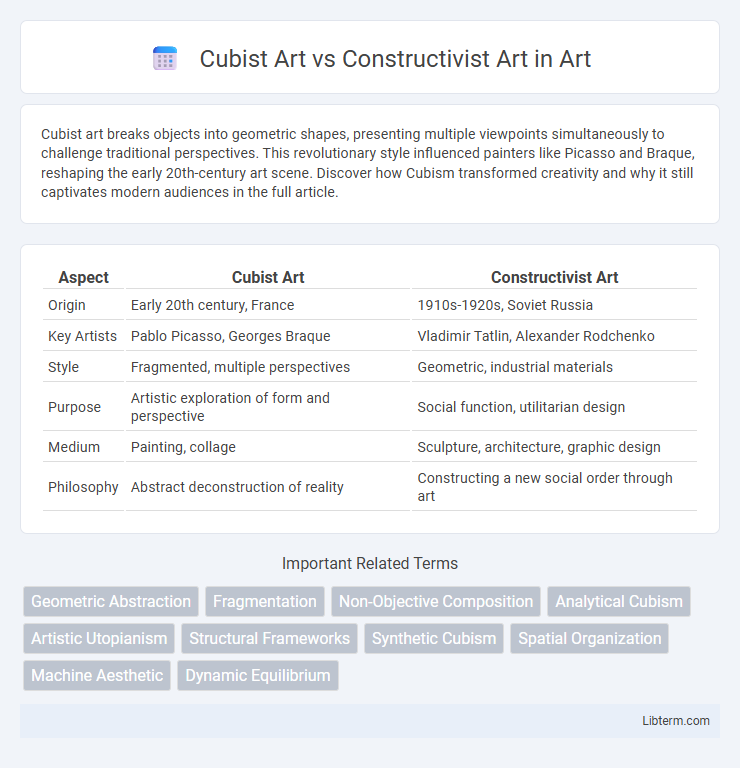Cubist art breaks objects into geometric shapes, presenting multiple viewpoints simultaneously to challenge traditional perspectives. This revolutionary style influenced painters like Picasso and Braque, reshaping the early 20th-century art scene. Discover how Cubism transformed creativity and why it still captivates modern audiences in the full article.
Table of Comparison
| Aspect | Cubist Art | Constructivist Art |
|---|---|---|
| Origin | Early 20th century, France | 1910s-1920s, Soviet Russia |
| Key Artists | Pablo Picasso, Georges Braque | Vladimir Tatlin, Alexander Rodchenko |
| Style | Fragmented, multiple perspectives | Geometric, industrial materials |
| Purpose | Artistic exploration of form and perspective | Social function, utilitarian design |
| Medium | Painting, collage | Sculpture, architecture, graphic design |
| Philosophy | Abstract deconstruction of reality | Constructing a new social order through art |
Introduction to Cubist and Constructivist Art
Cubist art, pioneered by Pablo Picasso and Georges Braque in the early 20th century, emphasizes fragmented objects, multiple perspectives, and geometric forms to challenge traditional representation. Constructivist art, emerging in post-revolutionary Russia with artists like Vladimir Tatlin and Alexander Rodchenko, focuses on abstraction, industrial materials, and functional design to reflect modernity and social purpose. Both movements revolutionized visual language but differed in goals, with Cubism exploring perception and form, while Constructivism prioritized practical application and ideological function.
Historical Origins and Influential Artists
Cubist Art, emerging in the early 20th century, was pioneered by Pablo Picasso and Georges Braque, emphasizing fragmented forms and multiple perspectives influenced by African art and Cezanne's approach to geometry. Constructivist Art, originating in Russia around 1915, was driven by Vladimir Tatlin and Alexander Rodchenko, focusing on abstract, functional design and the integration of art with industrial materials reflecting Soviet ideals. Both movements significantly shaped modern art, with Cubism revolutionizing visual representation and Constructivism merging art with social purpose and technological innovation.
Philosophical Foundations and Core Principles
Cubist art deconstructs objects into geometric shapes and multiple perspectives to challenge traditional representation, emphasizing subjective experience and the fragmentation of reality as influenced by Henri Bergson's philosophy of time and consciousness. Constructivist art focuses on functionalism and art's social utility, rooted in Marxist ideology promoting art as a tool for social transformation and collective progress. Core principles of Cubism include analytical observation and multiplicity of viewpoints, while Constructivism prioritizes abstraction, industrial materials, and integration of art into everyday life.
Techniques and Materials: A Comparative Analysis
Cubist art employs fragmented, geometric shapes and multiple perspectives to deconstruct subjects, often using oil paints on canvas to create layered textures and depth. Constructivist art emphasizes industrial materials such as metal, glass, and plastic, integrating sculpture and architecture with a focus on functional design and spatial dynamics. Techniques in Constructivism prioritize assembly, engineering principles, and the use of modern technology, contrasting with Cubism's painterly exploration of form and perception.
Representation of Space and Form
Cubist art, pioneered by artists like Pablo Picasso and Georges Braque, deconstructs objects into fragmented, geometric shapes to represent multiple viewpoints simultaneously, challenging traditional single-perspective space. Constructivist art, emerging in early 20th-century Soviet Russia with figures like Vladimir Tatlin and Alexander Rodchenko, emphasizes abstract, industrial forms and spatial organization to convey functional, material reality through dynamic compositions. Cubism explores a conceptual space by overlapping planes and facets, while Constructivism uses geometric forms and spatial relationships to reflect social utility and technological progress.
Color Theory and Palette Preferences
Cubist Art typically employs a muted color palette dominated by earthy tones, grays, and browns to emphasize form and structure over color, utilizing limited hues to convey fragmented perspectives and spatial depth. In contrast, Constructivist Art favors bold, primary colors such as red, black, white, and occasionally yellow, reflecting its emphasis on geometric abstraction and utilitarian design rooted in political and industrial themes. The Cubist approach to color theory prioritizes subtle tonal variations to enhance dimensionality, whereas Constructivism utilizes stark color contrasts to create visual dynamism and ideological clarity.
Key Works: Iconic Examples in Both Movements
Cubist art, exemplified by Pablo Picasso's "Les Demoiselles d'Avignon" and Georges Braque's "Violin and Candlestick," revolutionized visual perspective through fragmented forms and multiple viewpoints. Constructivist art, with key works like Vladimir Tatlin's "Monument to the Third International" and El Lissitzky's "Beat the Whites with the Red Wedge," emphasized abstract geometric shapes and social utility rooted in revolutionary ideology. These iconic pieces highlight Cubism's focus on deconstructed representation versus Constructivism's commitment to functional, politically charged design.
Influence on Modern and Contemporary Art
Cubist art, pioneered by Pablo Picasso and Georges Braque, revolutionized visual perception by fragmenting objects into geometric shapes, profoundly influencing modernist movements like Futurism and Dadaism. Constructivist art, emerging from post-revolutionary Russia with artists like Vladimir Tatlin and Alexander Rodchenko, emphasized functional design and materiality, shaping modern architecture, graphic design, and industrial aesthetics. Both movements contributed to contemporary art by challenging traditional representation and promoting abstraction, innovation, and interdisciplinary experimentation.
Reception and Critique by Art Critics
Cubist Art faced initial confusion and resistance from traditional critics due to its fragmented forms and abstracted perspectives, yet it gained substantial acclaim for redefining spatial representation and influencing modern art. Constructivist Art was often praised by early 20th-century critics for its utilitarian approach, emphasis on industrial materials, and alignment with socialist ideals, though some dismissed it as overly functional and lacking emotional depth. Both movements significantly impacted avant-garde discourse, with Cubism celebrated for its innovation in visual language and Constructivism revered for merging art with practical design.
Lasting Legacy and Cultural Impact
Cubist Art revolutionized visual perception by deconstructing objects into geometric forms, influencing modern art, design, and architecture throughout the 20th century. Constructivist Art, rooted in Soviet ideology, emphasized art's utility in social and political contexts, shaping propaganda, graphic design, and industrial aesthetics during and beyond the Russian avant-garde era. Both movements left enduring legacies by challenging traditional artistic norms and integrating art into broader cultural, technological, and societal frameworks.
Cubist Art Infographic

 libterm.com
libterm.com